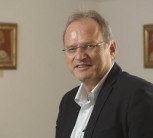The United Nations in Geneva has released global standards on the use of force by the police worldwide. UN High Commissioner for Human Rights Michelle Bachelet welcomed the new United Nations Human Rights Guidance on the Use of Less-Lethal Weapons in Law Enforcement and urged all states to follow it.
The Guidance sets out the different kinds of weapons that are available to the police today, and identifies the conditions under which they may and may not be used. The High Commissioner thanked the University of Pretoria and the Geneva Academy and in particular Professor Christof Heyns, who teaches at both these institutions and lead the process of drafting the Guidance in collaboration with the UN Office of the High Commissioner for Human Rights.
Heyns proposed the drafting of such standards in a report to the UN Human Rights Council when he served as UN Special Rapporteur on arbitrary executions six years ago. According to Heyns: “After the abuses that came with the Arab Spring we all thought something must be done.” Three years ago a group of global experts – including members of the police, ballistics experts, and lawyers – was convened. They met regularly in Geneva to draft the standards, with Heyns chairing meetings. “We certainly hope this will make a difference, and we are getting reports that police forces and others are using it,” he said. “It is to be welcomed that the police in many countries today have weapons that are less lethal than firearms, but the potential for abuse is sometimes even greater, precisely because they are labelled less dangerous. And as we know too well, they still kill and wound people.”
The world has recently witnessed shocking examples of the excessive use of force by law enforcement officials in many countries. The deaths of George Floyd in the USA and Collins Khoza in South Africa are just the latest examples of a long line of such tragic events, for example during demonstrations, arrest, and enforcement of COVID-19 regulations. One in 25 violent deaths worldwide takes place at the hands of the police and, in many cases, this is exacerbated by racial bias.
Speaking during an urgent debate in the Human Rights Council on racism and excessive use of force in policing on 17 June, Bachelet, expressed her exasperation about the killings, saying, “Too little has changed over too many years.” She praised the new standards as a significant addition to the efforts of the UN to provide law-enforcement officials with guidance on the use of force. “The Guidence is concise and user-friendly, outlining international norms and standards on the use of less-lethal weapons in a scenario-based, weapon-specific manner.”
The advance version of the Guidance was made available last year, and has already been used widely by police forces and others globally, including in countries such as Chile, Jamaica, Iraq, and Russia and in South Africa in the Khoza judgement, in addition to the UN and the Red Cross.
Heyns, together with UP colleagues Professor Stuart Maslen and Dr Thomas Probert, also lead the drafting of the 2016 UN standards on the investigation of unlawful death, and he is currently leading the process in the UN Human Rights Committee to develop new comprehensive UN guidelines on how states should handle gatherings.
Watch the documentary in the sidebar as Prof Christof Heyns and his team take us through what inspired them to lead the way and how less lethal force could be used by police as 2020 became characterised by the Black Lives Matter protests which unfolded across the world as a reaction to police brutality in America.
Research from the University of Pretoria’s Faculty of Law has become a global benchmark for a major US-based study on the use of force by police in America.
In the wake of the deaths of George Floyd, Laquan McDonald, Eric Garner, Michael Brown, Ahmaud Arbery, Tony McDade, Regis Korchinski-Paquet, Breonna Taylor and many others at the hands of the police, the new study was released by the University of Chicago’s Law School.
The starting point of the study is what it identifies as ‘the three most important sources on police use of force in international law’. These are the United Nation’s (UN) 1979 Code of Conduct for the Police, the 1990 Basic Principles on the Use of Force, and the international standards as set out by UP Professor Christof Heyns in a 2014 report to the UN Human Rights Council. He presented this report to the Council while serving as the special advisor to the UN on arbitrary killings.
In this report, Prof Heyns recommended the UN adopt specific guidance on the use of less-lethal weapons, an underdeveloped area of international law, where the uncertainties often lead to abuse, injury and death, especially in the context of demonstrations. The UN accepted his recommendation and Prof Heyns, with colleagues from UP’s Faculty of Law, then headed the process of drafting the guidelines. These guidelines set out the UN’s position of the use of batons, tear gas, pepper spray, Tasers and other less-lethal weapons. They have been used widely in dealing with recent demonstrations, for example in Chile, Georgia, Hong Kong, Iraq, and Jamaica. The advance edition of the United Nations Human Rights Guidance on the Use of Less-Lethal Weapons was launched in 2019. The final version will be released at the end of June 2020.
The University of Chicago study, Deadly Discretion: The Failure of Police Use of Force Policies to Meet Fundamental International Human Rights Law and Standards, compares and analyses in depth the policies and practices of 20 police departments of the 20 largest cities in the US with the norms set by international law.
According to the study leader, Professor Claudia Flores, of the University of Chicago’s Law School, none of the police departments have a use-of-force policy which meets the international standards. Instead, in some cases, policies justify lethal use of force for ‘escaping suspects’ or ‘fugitives’, or even more generally for ‘self-defense’ or ‘prevention of crime’, regardless of the threat posed to officers or civilians.
The study reveals that ‘Ultimately, deep, structural reform of the United States’ law enforcement system is needed. The police in the United States kill more people than any of our peer nations. In a 24-day period in 2015, police in the United States shot more people than the police did in England and Wales in 24 years. By all measures, the current system is broken. As this report demonstrates, the very laws and departmental policies meant to guide police officers on how to make the difficult, life and death decisions required of them, do not comply with human rights’.
The University of Chicago study draws extensively on a 2015 study by Amnesty International on the use of force by the police worldwide. This study also took as a central reference point the exposition of the international standards in the 2014 UN Report by Prof Heyns. In particular, they relied on the ‘protect life principle’ which, according to Prof Heyns, “lies at the core of contemporary international law on police use of force – and the violation of which has caused the tragedies we have witnessed all too often in recent times.”
Researchers in the Faculty of Law at the University of Pretoria (UP) led the process to draft the first United Nations (UN) international standards on the use of less lethal weapons. They developed the UN Human Rights Guidance on Less Lethal Weapons in Law Enforcement in collaboration with the Geneva Academy of International Humanitarian Law and Human Rights, for the UN Office of the High Commissioner for Human Rights.
The Guidance was developed under the auspices of three researchers in the Faculty of Law at UP. Professor Christof Heyns, who is also a member of the UN Human Rights Committee and a lecturer at the Geneva Academy, led the project and worked with Professor Stuart Maslen and Dr Thomas Probert, and a group of other experts, who together drafted the Guidance over a two-year period. The expert group included UN experts, law enforcement officials, experts in police oversight, academics and representatives of NGOs, civil society and weapon manufacturers from a range of countries. Expert meetings were held in Cambridge, Geneva and Pretoria.
The launch will take place at the Palais Wilson, the human rights headquarters of the UN, on Friday, 25 October 2019. One of the keynote speakers will be UP doctoral student on peaceful assemblies, Beryl Orao, a staff member of the Kenya National Human Rights Commission.
The Guidance is designed to build upon existing standards such as the UN Basic Principles on the Use of Force and Firearms by Law Enforcement Officials and has already been used by the UN in its response to the demonstrations in Hong Kong.
According to Prof Heyns, this is the culmination of a long process.
“Over the last decade we have developed several UN legal standards on issues relating to the conduct of the police, but finalising the Guidance was somewhat delayed. Less lethal weapon technologies – such as tasers and dazzling and acoustic weapons – only came into use relatively recently, to be used alongside contemporary equipment such as batons and water cannons. As a result, they are still largely unregulated.
“We welcome the fact that lately the police have an increased range of options as, in principle, they must use minimal force weaponry instead of firearms. However, we all know that these weapons are often abused with lethal results, which gave rise to the need for more certainty and guideline principles regarding which weapons may be used under which conditions, if at all.”
Members of the South African Police Service were also involved in the Geneva part of the project. A UP Engineering master's student who has developed a new, less lethal weapon combining kinetic and chemical agents to disperse force more accurately and safely also participated.
Click here for more on the launch of the UN Human Rights Guidance on Less Lethal Weapons in Law Enforcement.
Prof Christof Heyns
July 8, 2020

 Story
Story
Generative artificial intelligence (GenAI) is changing how we work, play and relax. Whether you use ChatGPT to write a brief, Midjourney to generate visuals or MuseNet to create unique soundtracks, these technologies have opened up opportunities for richer content.
 Story
Story
The latest issue of the University of Pretoria’s award-winning RE.SEARCH magazine is available now and reflects a shift towards both a fresher design and outlook. This edition is curated under the theme ‘Digital’, and offers a glimpse into some of the fascinating research we’re doing at UP to drive digital leadership and innovation.
 Story
Story
The articles in this edition showcase work from all nine of our faculties, and underscore our University’s slogan ‘Make today matter’. RE.SEARCH has been named South Africa's top corporate publication as the winner of the 2024 SA Publication's Forum Awards. It is a runner up and finalist in the Excellence category for Communication (runner up), Design and Photography (finalist) and the...
Copyright © University of Pretoria 2025. All rights reserved.
Get Social With Us
Download the UP Mobile App